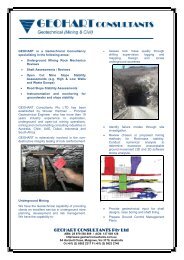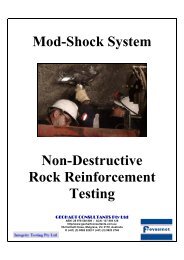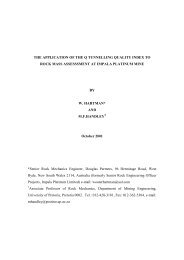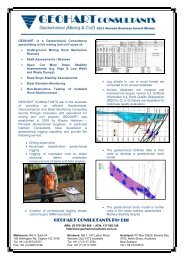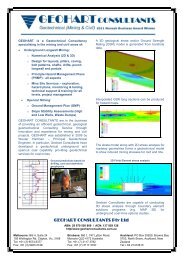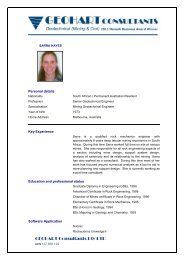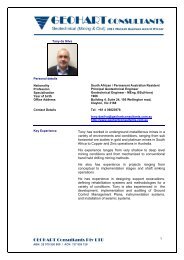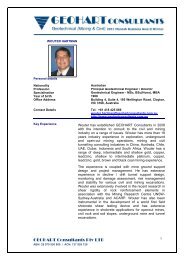Managing Geotechnical Risk through Non-Destructive Rock ...
Managing Geotechnical Risk through Non-Destructive Rock ...
Managing Geotechnical Risk through Non-Destructive Rock ...
Create successful ePaper yourself
Turn your PDF publications into a flip-book with our unique Google optimized e-Paper software.
CONCLUSIONS<br />
The non-destructive calibration testing conducted using the Modshock System will provide George<br />
Fisher rock mechanics personnel with some confidence in detecting rock reinforcement subject to<br />
corrosion and/or poor quality installation. The rock reinforcement installation for calibration<br />
purposes was done in a semi controlled environment where bolts were installed to simulate either<br />
poor installation techniques or damaged / corroded elements.<br />
The test work on the cable bolts was slightly affected by gaps behind the plates (i.e. plates not tight<br />
with excavation surface – this is caused by the uneven nature of the rock surface). This had a<br />
distorting affect on the signals, some of which could not be relied on for analysis purposes and thus<br />
required several attempts to obtain a proper / valid signal.<br />
During our investigation (calibration testing) on the cable bolts we noticed an interesting<br />
disturbance phenomenon in the 2D mechanical admittance plot for all the cable bolts tests and<br />
which were previously noticed when testing cable bolts at another mine. This relates to the first part<br />
of the mechanical admittance plot. Following an investigation into cable bolt behaviour an article<br />
was found describing load / strain dissipating from the collar, which could be an explanation for the<br />
disturbance in the 2D mechanical admittance plot. This phenomenon however would need to be<br />
confirmed with some instrumented bolts.<br />
The test results for the calibration bolts showed that the grout / resin embedded and free length of<br />
the cable bolts and resin bolts were clearly detected using the Modshock System. However the<br />
anticipated grout / resin locations for a few of the test specimens could not be accurately picked, as<br />
the location of the grout / resin appeared to be in a slightly different location than what has been<br />
proposed. Discussions surrounding this let us to believe that the lack of proper control (i.e. not<br />
laboratory environment) during the grout / resin installation could very well be the reason for<br />
detecting some of the resin / grout installations in another location.<br />
As the main use for the Modshock system is mainly to determine the integrity of rock reinforcement<br />
elements, the calibration testing provided us with enough confidence to use the Modshock system<br />
as a quality control tool. The two loading calibration tests (i.e. cumulative load pull tests compared<br />
with load stiffness calculations from the Modshock Tests for the elastic deformation range)<br />
conducted on resin bolts are inconclusive at this stage as only one of the two tests had positive<br />
results. Tests 8-15 (i.e. resin bolt encapsulation of 0.5m) showed a gradual increase in calculated<br />
bar stiffness (i.e. 0.6 - 3.9 tonnes/mm) from test 8 <strong>through</strong> to test 15, which indicates that the<br />
Modshock system do capture the bolt load response. There was also noticeable correlation between<br />
17



